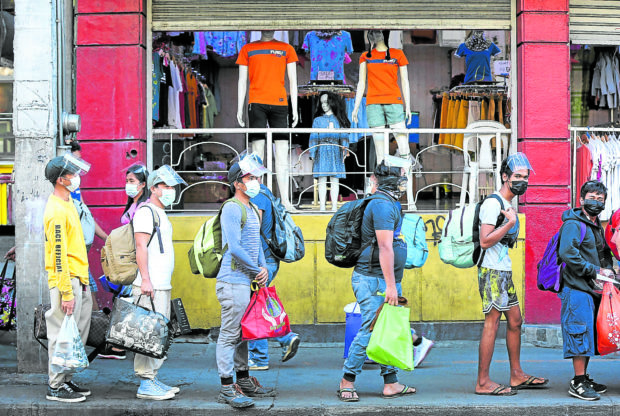
WAITING FOR A BUS People in face masks and face shields wait for a ride at the Nepa Q-Mart bus station in Quezon City. —NIÑO JESUS ORBETA
MANILA, Philippines — The number of adult Filipinos who remain jobless as of May 2021 slightly went down to 12.2 million compared to November 2020 figures, but Social Weather Stations (SWS) said that this is still higher than data from before the COVID-19 pandemic.
According to SWS, adult joblessness rate according to their April 28 to May 2 surveys was at 25.8 percent of the labor force. This is lower compared to the November figures of 27.3 percent or 12.7 million in November 2020.
However, this is also 8.3 percentage points higher than the joblessness rate before the health crisis took place, as it was only at 17.5 percent last December 2019.
“The national Social Weather Survey of April 28–May 2, 2021, found adult joblessness at 25.8% of the adult labor force. This is 1.5 points down from the 27.3% in November 2020 but still 8.3 points higher than the pre-pandemic level of 17.5% in December 2019,” SWS said.
“The jobless consist of those who (a) voluntarily left their old jobs, (b) are seeking jobs for the first time, or (c) lost their jobs due to economic circumstances beyond their control,” it added.
Still, it has relatively eased from the record-high 45.5 percent recorded last July 2020.
“Joblessness reached a record-high 45.5% in July 2020. It eased to 39.5% in September 2020, 27.3% in November 2020, and 25.8% in May 2021,” the polling firm noted.
SWS said that the lower joblessness rate was due to decreases in Metro Manila and Luzon — which was offset by higher unemployment rates in Visayas and Mindanao.
Joblessness decreased by nine points in Luzon, and seven points in Metro Manila. However, these were negated by the 10-point and six-point decreases in Visayas and Mindanao, respectively.
“Joblessness fell in Balance Luzon from 32.7% in November 2020 to 24.2% in May 2021. It fell in Metro Manila from 37.8% in November 2020 to 30.8% in May 2021,” SWS said.
“However, it rose in the Visayas, from 19.1% in November 2020 to 28.7% in May 2021. It also rose in Mindanao, from 17.0% in November 2020 to 23.0% in May 2021,” it added.
Unemployment spiked during the onset of the COVID-19 outbreak in the Philippines, as the government was forced to place Luzon and other parts of the country under strict lockdown from March 16, 2020 to May.
This led to closure of business belonging to non-essential industries, like tourism, aviation, leisure, and food and beverages. However, the situation improved after Metro Manila and other areas were placed under a less-restrictive general community quarantine (GCQ).
Between that time and May 2020, several areas also saw strict lockdowns because of COVID-19 surges. In August, the government heeded frontliners’ call for a break as cases were mounting back then.
Then by the end of March 2021, Manila and nearby provinces of Bulacan, Cavite, Laguna, and Rizal were placed under an enhanced community quarantine (ECQ) and then a modified ECQ (MECQ) to curb rising cases brought by new COVID-19 variants of concern.
According to SWS, the survey was conducted using face-to-face interviews of 1,200 adults, subdivided into 300 each for Balance Luzon, Metro Manila, Visayas, and Mindanao.
SWS maintains sampling error margins are ±3% for national percentages and ±6% for Balance Luzon, Metro Manila, the Visayas, and Mindanao.